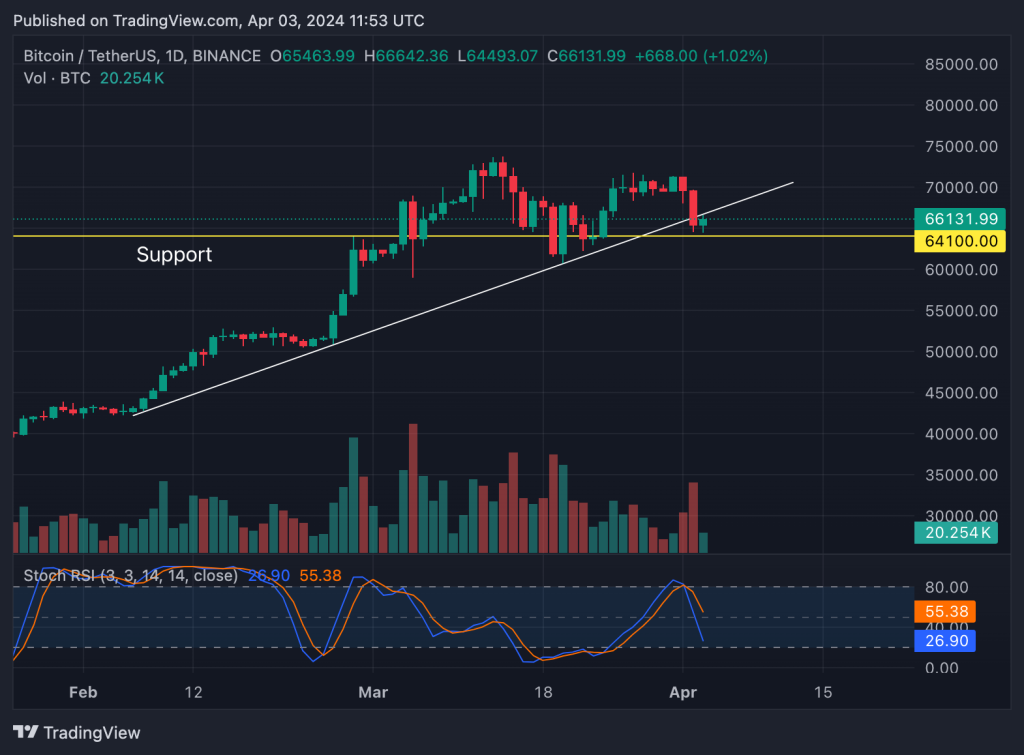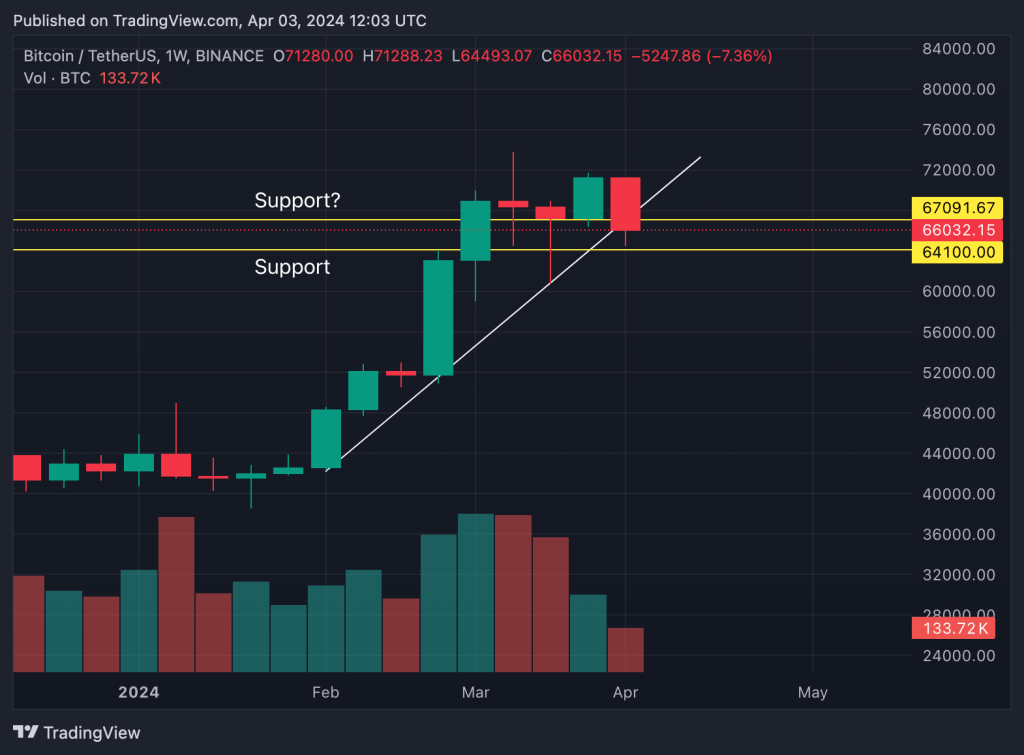The current state of the cryptocurrency market is marked by a palpable sense of nervousness, stemming from two consecutive days of downward price movement that have driven Bitcoin’s value back down to support levels hovering around $64,000. This abrupt reversal has left many investors on edge, particularly in light of ongoing developments such as the Grayscale Bitcoin Trust (GBTC) continuing to offload Bitcoin onto the market, coupled with the looming possibility of the US government selling an additional $2 billion worth of Bitcoin.
The recent price action has cast doubt on the sustainability of the market’s current rebound. Despite a monthly closure that saw Bitcoin comfortably above the $69,000 mark, the optimism that accompanied this milestone has been overshadowed by the persistent selling pressure exerted by the Grayscale ETF (GBTC). It’s worth noting that the strong selling days observed in GBTC contrast sharply with the comparatively weaker buying activity witnessed across other Spot Bitcoin ETFs, further exacerbating the market’s volatility and uncertainty.
The impact of these developments cannot be overstated. Investors who had hoped for a continuation of Bitcoin’s upward trajectory following its impressive monthly close now find themselves grappling with the reality of a market besieged by conflicting forces. On one hand, there is the persistent downward pressure exerted by entities like the Grayscale ETF, whose selling activity threatens to undermine any potential price gains. On the other hand, there is the specter of impending government intervention, with the US government’s potential sale of $2 billion worth of Bitcoin looming large on the horizon, adding an additional layer of uncertainty to an already tumultuous market environment.
In essence, what we are witnessing is a delicate balancing act between bullish optimism and bearish skepticism. The question on everyone’s minds is whether the current price rebound can withstand the barrage of selling pressure from institutional players like Grayscale and the potential influx of supply from government sales. As investors nervously monitor the ebb and flow of market dynamics, the fate of Bitcoin hangs in the balance, its future trajectory uncertain amidst the swirling currents of speculation and uncertainty.
US government about to sell?
The recent colossal movement of $2.1 billion worth of Bitcoin by the United States government onto the Coinbase exchange has sent ripples of speculation throughout the cryptocurrency community. This significant transfer has ignited concerns regarding its potential impact on the already volatile price of Bitcoin.
At this juncture, the timing of the US government’s maneuver is particularly noteworthy. It raises eyebrows and prompts questions about potential ulterior motives. One cannot help but ponder whether this strategic move is a deliberate attempt to capitalize on Bitcoin’s perceived vulnerability, aiming to exert downward pressure on its price and perhaps breach a critical support level. While such conjecture remains speculative, it’s hard to ignore the prevailing sentiment of distrust and skepticism towards the cryptocurrency industry within certain echelons of the Biden administration.
Indeed, this latest action by the US government is not occurring in a vacuum. It is part of a broader narrative of regulatory scrutiny and governmental intervention in the cryptocurrency space. Given the Biden administration’s stance on crypto, which has been characterized by skepticism and caution, one could argue that this move is emblematic of a larger strategy to assert control and temper the perceived risks associated with digital assets.
However, one must pause to consider the potential ramifications of such actions. Selling off yet another portion of the Silk Road haul, despite its legality, could be construed as short-sighted. It fails to acknowledge the evolving landscape of Bitcoin and cryptocurrencies, wherein they are increasingly being recognized as legitimate financial instruments and potential storehouses of value. In this context, the US government’s decision to offload its Bitcoin holdings might be seen as a missed opportunity to stake a claim in an emerging digital economy, one in which even nation-states are compelled to take a position.
As we peer into the future, it becomes increasingly evident that Bitcoin’s prominence is unlikely to wane. Its decentralized nature, combined with its scarcity and utility, positions it as a formidable force in the global financial ecosystem. Thus, while the US government’s actions may be driven by immediate concerns and political considerations, they risk underestimating the long-term significance of Bitcoin and cryptocurrencies.
In conclusion, the transfer of $2.1 billion worth of Bitcoin by the US government onto the Coinbase exchange serves as a poignant reminder of the complex interplay between government regulation, market dynamics, and the evolving nature of digital currencies. While the short-term impact on Bitcoin’s price remains uncertain, the broader implications of such actions underscore the need for a nuanced understanding of the role of cryptocurrencies in shaping the future of finance.
Mr 100 hoovers up whole daily issuance of $BTC
On the opposite end of the spectrum, there exists a significant player in the cryptocurrency arena known by the moniker “Mr. 100.” This individual has garnered a reputation for their consistent and substantial acquisitions of bitcoin, each transaction typically comprising 100 BTC. However, recent events have catapulted Mr. 100 into the limelight once again. Within the span of a mere 36 hours, stretching from this past Tuesday, Mr. 100 managed to amass a staggering 1,256 BTC.
To contextualize the magnitude of this acquisition, it’s crucial to consider the daily production rate of bitcoin. As it stands, a finite quantity of only 900 BTC is mined each day. Thus, the sheer magnitude of a single entity acquiring a lion’s share of this daily production capacity in such a condensed timeframe prompts a myriad of contemplations.
This exceptional buying spree serves as a glaring testament to the dynamics at play within the cryptocurrency ecosystem. It not only underscores the voracious appetite of certain entities within the market but also raises pertinent questions regarding market manipulation and concentration of power. The spectacle of one individual essentially cornering the market to such an extent is bound to give even the most seasoned investors pause for thought.
Moreover, this scenario casts a glaring light on the actions of governmental bodies, particularly the United States government, which has been gradually divesting itself of its considerable bitcoin holdings. In juxtaposition to the aggressive acquisition strategy of Mr. 100, the government’s actions may appear misguided and lacking in foresight. While the government relinquishes its stake, potentially undervaluing a burgeoning digital asset, entities like Mr. 100 capitalize on the opportunity, further solidifying their position within the cryptocurrency market.
Thus, this narrative serves as a poignant reminder of the ever-evolving landscape of the cryptocurrency domain, where individual players wield considerable influence and strategic maneuvers can have profound ramifications. As Mr. 100 continues to make waves with their formidable purchasing power, observers are left to ponder the implications of such dominance and the broader ramifications for the future of digital currencies.
$BTC support holding?
Examining the daily time frame of Bitcoin’s price reveals a significant development: a breach of the trend line, followed by a consolidation phase below it. This shift in trajectory, however, hasn’t overwhelmed the support level below, which has demonstrated resilience thus far. Additionally, the gap on the Chicago Mercantile Exchange (CME) chart, located at this critical level, has nearly closed, indicating a convergence of market forces.
What warrants keen observation now is the impending closure of the daily candle. Will it decisively settle below the trend line, solidifying the bearish sentiment? Yet, it’s crucial to underscore that the horizontal support level holds pivotal importance in determining the market’s direction. Delving deeper into the analysis, we find intriguing signals on shorter time frames: the Stochastic RSI momentum indicator is undergoing a reset at the lower end, suggesting a potential shift in momentum. Moreover, while the daily chart continues its downward trajectory, there’s a subtle indication that upward momentum might be gearing up for a resurgence in the near term.

In essence, this juncture presents a critical moment for Bitcoin, where multiple indicators and technical factors converge, hinting at the possibility of a significant market move in the coming sessions. As traders and analysts await the outcome, the interplay between support, resistance, and momentum remains central to deciphering the cryptocurrency’s next move.

Weekly close will give clearer guide
Taking a broader view by examining the weekly timeframe, we observe a clearer picture. It’s evident that Bitcoin ($BTC) has solidified its support level around $64,000. However, there’s still uncertainty surrounding whether it will maintain support at $67,000 and the accompanying support trend line.
A crucial indicator of bullish momentum would be if Bitcoin manages to reclaim the $67,000 level by the week’s end. The closing price action on Sunday will hold significant importance in assessing whether the ongoing rally in Bitcoin will persist or if there’s potential for a more substantial correction ahead.



